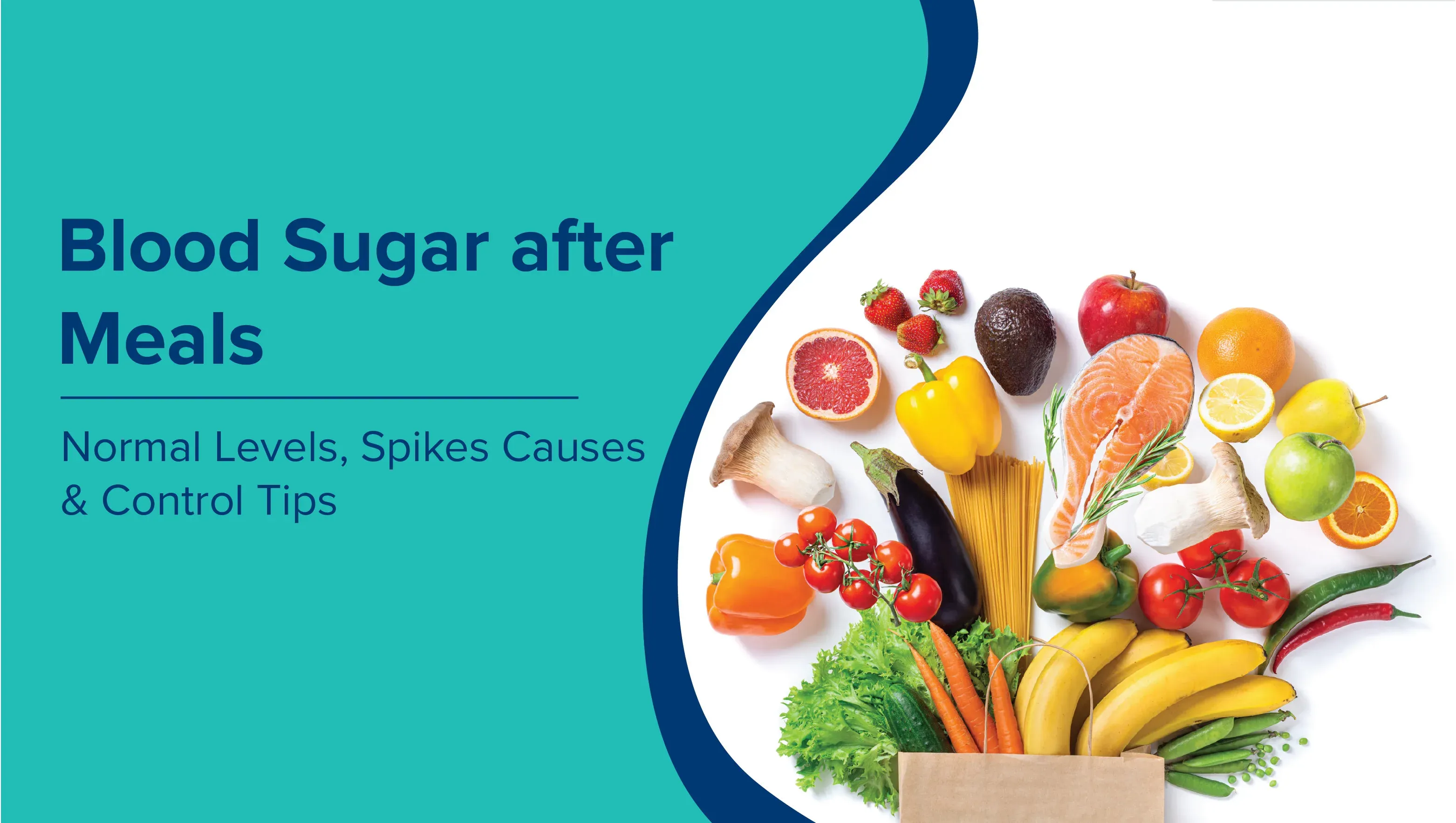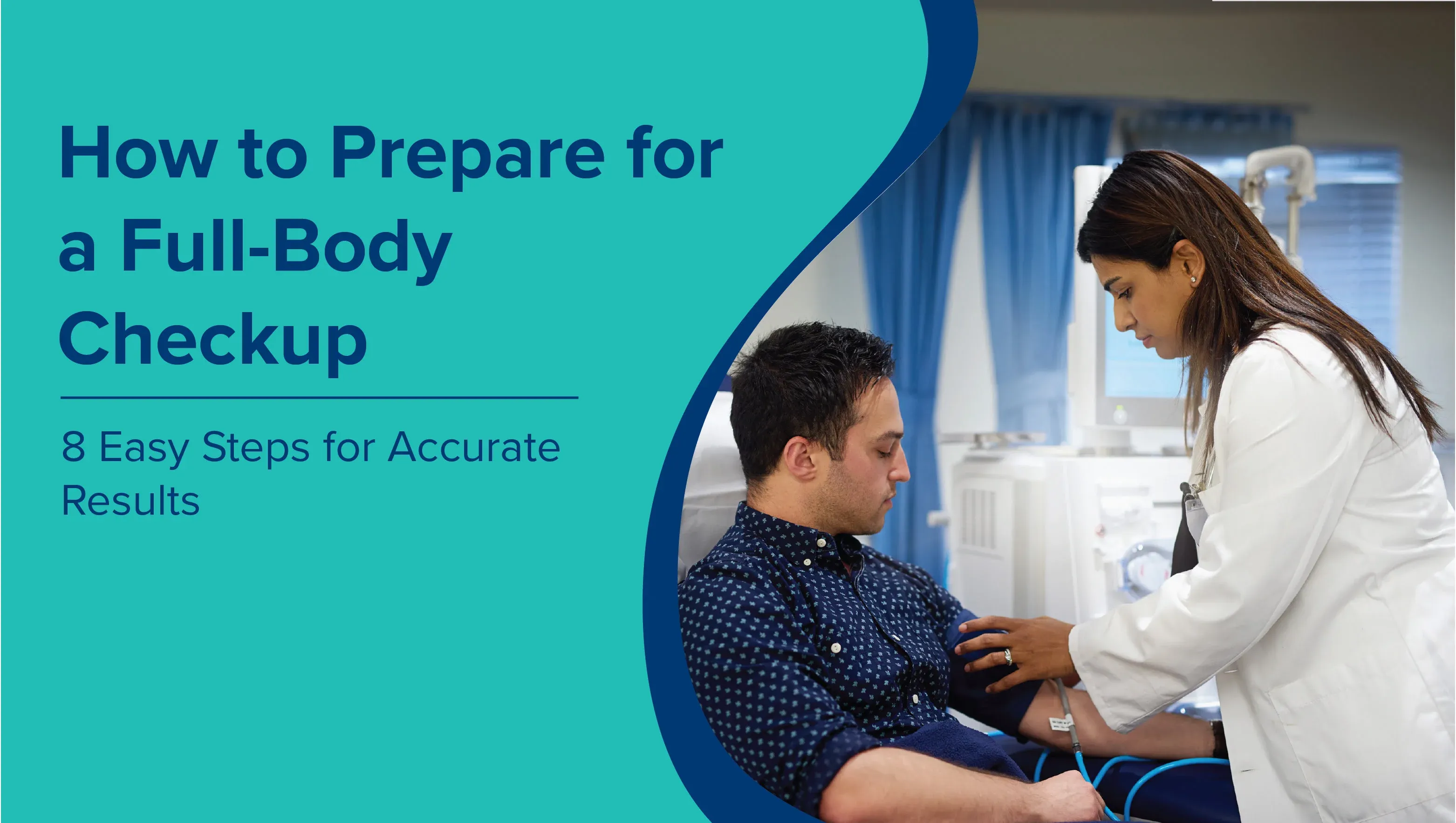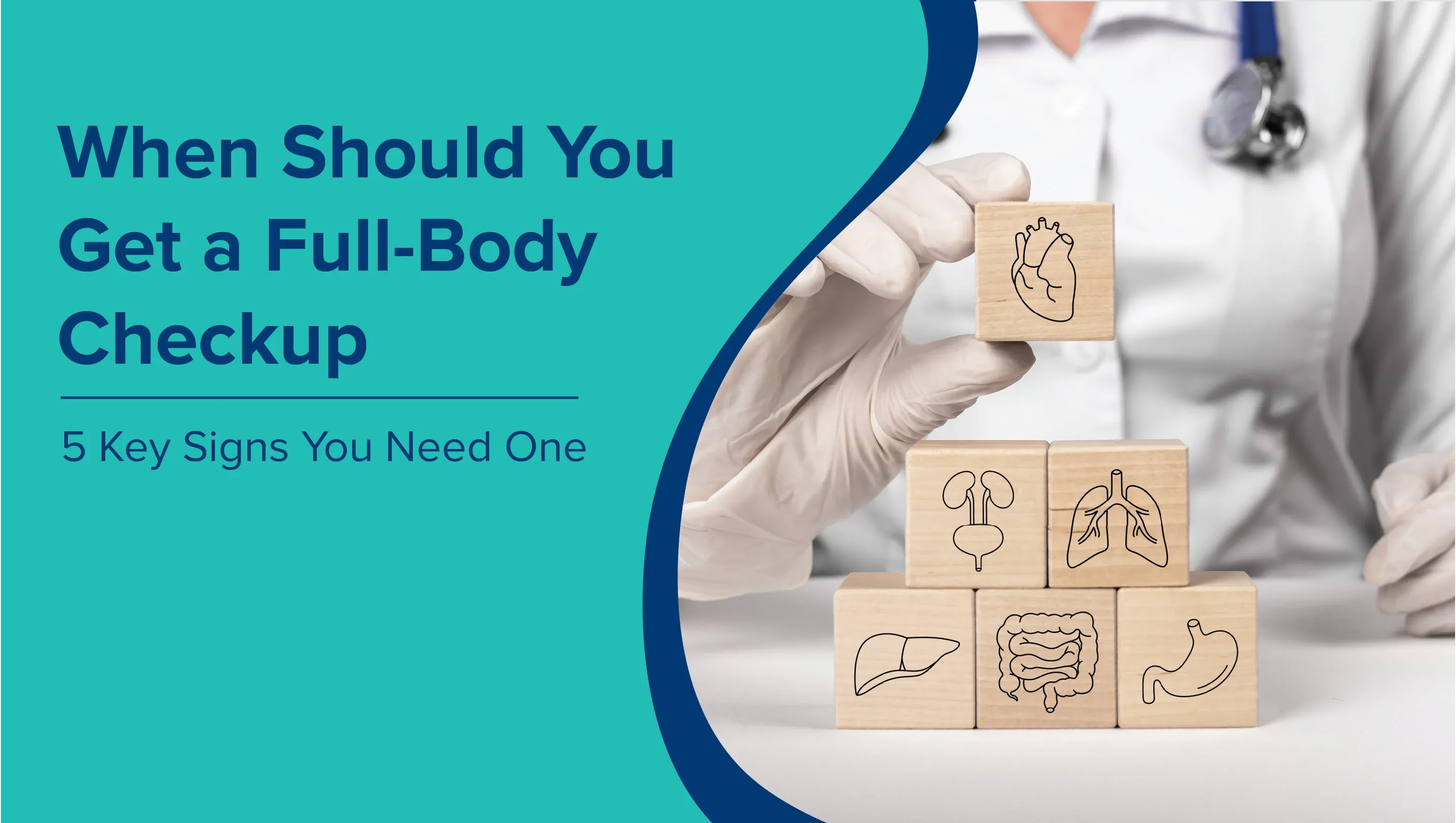Blood sugar levels typically increase after meals, as the body breaks down food into glucose. Keeping these levels within a healthy range, however, is crucial for maintaining energy, preventing complications, and supporting overall wellbeing. Whether someone is managing a health condition or focusing on general wellness, understanding blood sugar patterns after meals can help prevent long-term health issues and support overall wellbeing. In this article, we’ll understand what qualifies as “normal sugar levels” after having a meal, why the level may spike sometimes, and how to manage it through smart choices. But first, let’s understand the basics.
What Does Eating Affect Blood Sugar?
After a meal - especially if it’s rich in carbohydrates - the body begins to break down food into glucose. This glucose enters the bloodstream, causing blood sugar levels to rise. In response, the pancreas releases insulin: a hormone that helps transport glucose into cells for energy or storage. This process is essential for maintaining balanced blood sugar levels. However, the extent and speed of the rise can vary based on the type of food eaten, portion size, physical activity, and individual metabolism. A healthy system will gradually bring the sugar level back to its normal range within two to three hours after eating.
Normal Blood Sugar Levels After Meals
Blood sugar levels typically peak within 1 to 2 hours after eating. For most healthy adults, the normal post-meal (postprandial) blood glucose range is:
- Less than 140 mg/dL two hours after eating
- 70–130 mg/dL before the next meal
However, these values can vary slightly depending on age, health status, and gender. For example:
- Older adults may have slightly higher acceptable post-meal readings
- Women, especially during pregnancy, are often advised to maintain tighter sugar control
- People with diabetes may be given personalised target ranges by their doctors
A normal blood sugar levels chart can help track fluctuations and interpret results over time. It’s also useful to compare fasting levels with post-meal levels to assess how the body is managing glucose.
When Is Blood Sugar Considered High After Meals?
Blood sugar is considered high after meals if it consistently exceeds 180 mg/dL two hours after eating. This condition, known as postprandial hyperglycaemia, may signal insulin resistance or poor glucose regulation. Occasional spikes can happen due to a heavy meal or stress, but frequent elevations increase the risk of type 2 diabetes and other complications. Common high blood sugar symptoms after eating include:
- Fatigue or drowsiness
- Blurred vision
- Excessive thirst
- Frequent urination
- Headaches or difficulty concentrating
If these symptoms occur regularly, it’s important to monitor blood glucose levels closely and consult a healthcare professional for further evaluation.
Low Blood Sugar After Meals: What It Means
Experiencing low blood sugar (hypoglycaemia) after meals, though less common, can still occur, especially in individuals with diabetes or those on glucose-lowering medications. Post-meal hypoglycaemia typically happens within 2 to 4 hours after eating and may be triggered by:
- Skipping meals or eating late after medication
- Consuming high-sugar foods followed by a sharp insulin response
- Underlying metabolic conditions
Low blood sugar symptoms may include:
- Shakiness or dizziness
- Sweating
- Hunger or irritability
- Confusion or blurred vision
- Rapid heartbeat
If these symptoms appear, it’s crucial to consume a quick source of glucose, such as fruit juice or glucose tablets, and follow up with a balanced snack to stabilise sugar levels. Consistent episodes should be discussed with a doctor for proper diagnosis and treatment.
Why Blood Sugar Spikes Happen After Meals
Several everyday habits and health factors can cause post-meal blood sugar spikes. These spikes occur when the body cannot effectively manage the surge of glucose entering the bloodstream after eating. Common causes include:
- High-glycaemic foods such as white rice, sugary snacks, or processed meals
- Lack of fibre, protein, or healthy fats that help slow glucose absorption
- Eating large portions or heavy meals, especially with refined carbohydrates
- Skipping medications like insulin or oral glucose-lowering drugs
- Physical inactivity after meals
- Stress or illness, which can temporarily increase blood glucose levels
How to Control Blood Sugar After Eating
Managing post-meal sugar levels is key to preventing long-term complications and maintaining daily wellbeing. Some of the simple yet effective steps to control blood sugar post meal include:
- Choose balanced meals: Combine carbohydrates with protein, healthy fats, and dietary fibre to slow glucose absorption.
- Watch portion sizes: Eating smaller, more frequent meals can help prevent large spikes.
- Stay active: Light physical activity such as walking after meals improves glucose uptake by muscles.
- Take medications as prescribed: Never skip insulin or oral medications without medical advice.
- Stay hydrated: Water helps the kidneys flush out excess glucose.
- Check blood sugar regularly: Frequent monitoring helps identify patterns and adjust diet or treatment accordingly.
- Reduce stress: Mindfulness practices, yoga, or breathing exercises can support hormonal balance.
Best Foods to Manage Post-Meal Sugar Levels
Choosing the right foods can help prevent sudden spikes and dips in blood sugar after meals. Focus on options that release glucose slowly and support insulin function. Some effective choices include:
- Whole grains such as oats, brown rice, or whole wheat chapati
- Legumes like lentils, chickpeas, and kidney beans
- Vegetables rich in fibre, including spinach, okra, and bitter gourd
- Fruits with a low glycaemic index, such as guava, papaya, and apples
- Nuts and seeds (in moderation) for healthy fats and protein
- Curd or buttermilk for a probiotic and protein boost
- Cinnamon and fenugreek as natural insulin sensitisers in Indian diets
Note: For low blood sugar, quick-relief foods include bananas, glucose tablets, raisins, or a small glass of fruit juice, followed by a more balanced snack to maintain levels.
Tracking and Monitoring Post-Meal Sugar Levels
Regular monitoring helps assess how the body responds to food and supports timely medical decisions. For those managing diabetes or at risk, checking sugar levels after meals can reveal patterns and identify problem areas.
Key tips for effective tracking:
-
Use a glucometer: Measure blood sugar 1 to 2 hours after eating, when levels typically peak.
-
Keep a log: Record readings along with meal details, portion sizes, and physical activity.
-
Look for trends: Repeated high readings after similar meals may require dietary adjustments.
-
Follow medical advice: Doctors may recommend more frequent checks or continuous glucose monitoring (CGM) for those with unstable sugar levels.
Monitoring empowers individuals to take control of their health and adjust habits based on real-time insights.
When to See a Doctor
While occasional blood sugar fluctuations can be managed at home, persistent or extreme readings warrant medical attention. It’s advisable to consult a doctor if:
- Post-meal sugar levels consistently exceed 180 mg/dL
- Symptoms of high or low blood sugar occur frequently or severely
- Unexplained fatigue, weight changes, or vision issues develop
- You’re unsure how to adjust diet or medications
- There’s a family history of diabetes and early signs begin to appear
Early intervention can help prevent complications and provide tailored advice on diet, lifestyle, and medications to support stable blood sugar control.
Monitor Blood Sugar at Home with MaxAtHome
Keeping track of blood sugar after meals doesn’t always require a hospital visit. MaxAtHome offers convenient at-home blood sugar testing for individuals looking to manage their health more efficiently. Whether it’s a one-time random blood sugar test, fasting and postprandial glucose tests, or a full diabetes profile, all services are performed by trained professionals in the comfort of home.
Key benefits include:
- Safe home sample collection by certified phlebotomists
- Quick and accurate lab reports, accessible digitally
- QAI-accredited testing for reliability and peace of mind
- Available in multiple cities including Delhi, Noida, Gurugram, Mumbai, and Chandigarh
With MaxAtHome, routine sugar monitoring becomes easier, more affordable, and hassle-free. Schedule the test online through our easy-to-use booking platform or call 09240299624 to get started today.
Frequently Asked Questions
What is considered normal blood sugar after a meal?
Typically, a normal blood sugar level two hours after eating is less than 140 mg/dL for a healthy adult. Levels between 140–180 mg/dL may indicate prediabetes, and anything above 180 mg/dL is considered high.
What does the normal blood sugar range look like throughout the day?
The general range for most non-diabetic adults is:
- Fasting: 70–99 mg/dL
- Before meals: 70–130 mg/dL
- Two hours after meals: less than 140 mg/dL
- At bedtime: 100–140 mg/dL
Is there a normal blood sugar levels chart I can follow?
Yes, many health portals and doctors provide blood sugar levels charts categorised by fasting, post-meal, and random glucose readings, often segmented by age and health condition.
What causes a spike in blood sugar levels after eating?
Blood sugar spikes can result from high-carb or sugary meals, large portion sizes, lack of physical activity, stress, illness, or missed medication.
What are the symptoms of high blood sugar after meals?
Common signs include fatigue, increased thirst, frequent urination, blurry vision, and a foggy feeling. Repeated symptoms should be evaluated by a doctor.
What does low blood sugar after eating feel like?
Low blood sugar (hypoglycaemia) may cause dizziness, sweating, shaking, hunger, irritability, or confusion, especially in those with diabetes or on insulin.
What is a healthy post meal sugar level for women?
Women should aim for a reading under 140 mg/dL two hours after meals. This range may differ during pregnancy or menopause, and customised targets are often recommended.
What is the normal sugar level for adults after food?
For most adults, the normal post-meal sugar range is under 140 mg/dL at the 2-hour mark. Levels above this could signal impaired glucose tolerance.
What is the normal blood sugar 2 hours after eating?
Two hours post-meal, healthy individuals typically have a blood glucose level below 140 mg/dL. Diabetic targets may vary depending on individual treatment plans.
How much sugar level is normal immediately after eating?
Immediately after eating, levels may rise briefly but should not exceed 180 mg/dL. They should gradually fall to normal within 2–3 hours.
What to eat for low blood sugar after meals?
Quick options include glucose tablets, a glass of juice, or a banana. Follow up with a complex-carb snack like whole grain toast or curd with fruit for sustained control.
What is the normal sugar range in the human body?
In general, the healthy range is:
- Fasting: 70–99 mg/dL
- Post-meal: Under 140 mg/dL
- Random test: Under 200 mg/dL
What to do when blood sugar is high after eating?
Drink water, take a short walk, and avoid further carb intake. If levels stay high consistently, consult a doctor for medication adjustments or dietary review.
How to control sugar level immediately after a spike?
Mild exercise (e.g., walking), hydration, and avoiding sugary snacks can help bring levels down. Sudden or repeated spikes should be medically evaluated.
Is the normal blood sugar range different by age?
Yes. Older adults may have slightly more lenient targets due to other health risks, while children and pregnant women may have stricter ranges set by their healthcare provider.















